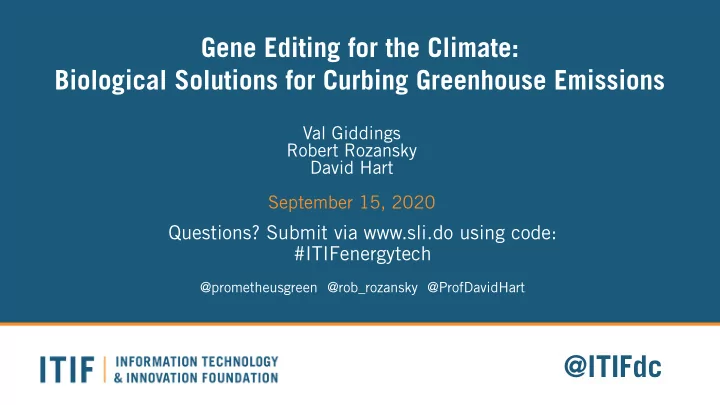

Gene Editing for the Climate: Biological Solutions for Curbing Greenhouse Emissions Val Giddings Robert Rozansky David Hart September 15, 2020 Questions? Submit via www.sli.do using code: #ITIFenergytech @prometheusgreen @rob_rozansky @ProfDavidHart @ITIFdc
Gene Editing for the Climate: Biological Solutions for Curbing Greenhouse Emissions Val Pamela David Rob Scott @ITIFdc
About ITIF Independent, nonpartisan research and education institute focusing on intersection of technological innovation and public policy, including: – Innovation and competitiveness – IT and data – Telecommunications – Trade and globalization – Life sciences, agricultural biotech, and energy Formulates and promotes policy solutions that accelerate innovation and boost productivity to spur growth, opportunity, and progress World’s top think tank for science and technology policy, according to the University of Pennsylvania’s authoritative Global Go To Think Tank Index 3
4
Contents Motivation: Biology’s Role in Climate Change 1 Gene Editing: New Tools for GHG Mitigation and Capture 2 Potential Applications in Key Sectors 3 4 Policy Recommendations 5
Motivation: Biology’s Role in Climate Change Greenhouse gases from living (or deceased) organisms are a major component of current GHG emissions Plants and microbes have great potential to reduce emissions Biological CO2 fixation can significantly expand existing carbon sinks Biological mechanisms for improving production efficiency (reducing emissions) and increasing Carbon capture can be improved and magnified through gene editing 6
Contents Motivation: Biology’s Role in Climate Change 1 Gene Editing: New Tools for GHG Mitigation and Capture 2 Potential Applications in Key Sectors 3 4 Policy Recommendations 7
Gene Editing: New Tools for GHG Mitigation and Capture Gene editing is the most recent stage in the development of techniques to improve plants, animals, and microbes for human uses It builds on earlier stages, from domestication through selective breeding, hybridization, to genetic engineering (recombinant DNA/transgenics) CRISPR-mediated gene editing is derived from defense mechanisms bacteria evolved to defend against predatory viruses Gene editing is more precise, predictable, and thus safer than older methods of genetic improvement (which were very safe ) It can be used to improve plants, animals, and microbes in myriad different ways 8
Gene Editing: New Tools for GHG Mitigation and Capture 9
Contents Motivation: Biology’s Role in Climate Change 1 Gene Editing: New Tools for GHG Mitigation and Capture 2 Potential Applications in Key Sectors 3 4 Policy Recommendations 10
Enhancing Photosynthesis to Cut Emissions & Increase CCUS 11
Agriculture: Minimizing Food Loss and Waste 12
Agriculture: Reducing Bovine Emissions 13
Transportation: Improving Biofuel Production 14
Negative Emissions: Enhancing Photosynthesis 15
Contents Motivation: Biology’s Role in Climate Change 1 Gene Editing: New Tools for GHG Mitigation and Capture 2 Potential Applications in Key Sectors 3 4 Policy Recommendations 16
Policy Priorities for the U.S. & International Community 1. Regulatory Reform 1 Unscientific regulations are barrier to innovation Agricultural biotech has record of safety (vetted by 11 National Academies studies) Potential Action: U.S. agencies implement Executive Order 13874 on streamlining ag biotech regulatory framework 17
Policy Priorities for the U.S. & International Community 1. Regulatory Reform 1 2. Increased R&D Investment 2 Investment in gene editing should increase severalfold R&D priorities include CRISPR fundamentals, soil carbon measurement methods, photosynthesis, and more Potential Action: Congress establishes ag-focused Advanced Research Projects Agency (e.g., ARPA-Terra) 18
Policy Priorities for the U.S. & International Community 1. Regulatory Reform 3. Improved Coordination of R&D Priorities 1 3 2. Increased R&D Investment 2 Domestic and international coordination can accelerate progress Potential Action: Nations leverage existing international efforts for multilateral coordination (e.g., Bill and Melinda Gates Foundation’s RIPE project) 19
Policy Priorities for the U.S. & International Community 1. Regulatory Reform 3. Improved Coordination of R&D Priorities 1 3 2. Increased R&D Investment 2 4. Incentives to Deploy Gene-Edited Technologies 4 Incentives facilitate broader adoption and cost reductions Potential Action: Governments expand conservation programs to incorporate gene-edited products for carbon sequestration 20
Thank You! Val Giddings | vgiddings@itif.org | @prometheusgreen Robert Rozansky | rrozansky@itif.org | @rob_rozansky David Hart | dhart@itif.org | @ProfDavidHart @ITIFdc
Science a and t nd technolo logy a are e essentia ial t to crop improvement /// Bayer Crop Science RESTRICTED
RESTRICTED
RESTRICTED
Recommend
More recommend